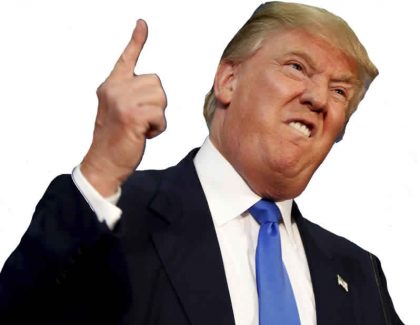Summertime, but where are the foreign tourists?
Ever since our forty-fifth president was elected, tourism to the United States from foreign countries has steadily dropped—in the face of a world-wide boom in travel—and the authoritative U.S. Travel Association has just provided me with figures projecting a further drop in 2018, from a share of worldwide tourism of 12.0 percent in 2017 to 11.7 percent this year. And this is after a drop in Trump’s first year in office from 12.9 percent. Though the numbers and differentials look small in percentages, they are large in terms of dollars not spent here by foreign tourists and they have serious negative implications for jobs not created.
What has caused this series of drops in foreign tourism since Donald Trump was sworn in as president? Trump’s rhetoric and new policies and rules and regulations regarding travel have combined to blot America’s long-standing image as a welcoming nation.
And of course his travel ban, a barely disguised version of the total ban on Muslims being allowed into this country he announced during his presidential campaign, inflamed worldwide opinion and in practical terms it barred visits by citizens of seven entire countries in the name of preventing terrorist attacks (though none have come from the countries the ban singled out).
The administration’s treatment of people attempting to flee here from violence-wracked Central American countries and Trump’s rhetoric about Mexico from the moment he entered the presidential race hasn’t encouraged Hispanics to come see our wondrous sights and enjoy our beautiful beaches. Trump’s withdrawal of the U.S. from the Paris Climate Accord hasn’t helped, nor have his rows with the leaders of friendly nations, which began almost from when he took office. Neither has Trump’s launching of a trade war. New visa-vetting policies have also caused delays and denials that didn’t used to occur. The invasive new tightening of airport security has put off numerous travelers to this country.
Maybe all these changes have prevented would-be terrorists from entering the U.S., but they for sure have also discouraged or denied many visitors with benign intentions.
The drop in tourism in 2017 was precipitous, and its velocity can be mainly attributed to one factor, what’s come to be called in the tourism industry the Trump slump. Earlier this year, Reuters quoted the head of a German company that specializes in trips to the United States as saying, “Politics is not helping us.” He added that since the price of the dollar was falling at that time, “we should have seen a much bigger increase in demand.”
The Pew Research Center Reserve found earlier this year that a survey of ten nations showed that a favorable opinion of the US occurred in only one country: Russia. The inescapable fact is that Trump’s presidency has coincided with an unprecedented drop in travel to the United States. The US’s share in worldwide travel increased steadily until 2015. While some attribute the recent drop in tourism to the U.S. to a strong dollar, in fact, the dollar was strong in 2015, when our tourism growth was at its apex, and it was strong in 2016. Yet when it declined in 2017, which should have helped tourism, foreign tourism to the U.S. dropped steeply that year. (After starting off weak earlier this year, the dollar’s been gaining in strength robustly, and the recent tightening of credit by the Federal Reserve will likely send the dollar even higher—which isn’t good for U.S. exports, which includes tourism.)
As it turns out, the US is one of only two countries in the developed world that saw a net drop in foreign travel from 2015 through 2017: the other nation sharing this dismal fate is that less-than-shining democratic beacon, Turkey, which comes out last in a ranking of 13 countries in terms of their share of people choosing to visit them. The U.S. comes in second-last. The governments of the United Kingdom and the U.S. have advised tourists to be wary of terrorism and violence in Turkey, whose authoritarian government is operating under a State of Emergency, and which suffered a precipitous drop in tourism in the past year. The only positive thing to say about the decline of tourism in the U.S. is that it hasn’t been as bad as Turkey’s —but the margin isn’t very wide. Recall that this downturn in travel to the U.S. has taken place amid a world-wide travel boom.
Here are the rankings in terms of percentage changes of various countries’ share of international tourism in 2017, according to the U.S. Travel Association:
Spain +32.7%
Australia +22%
Canada +21.2%
Øverst på formularen
Saudi Arabia +20.3%
United Kingdom +17.9%
United Arab Emirates 16.5%
Thailand +13.9%
China +9.3%
Germany +8%
France +4%
Italy +2.2%
US -6%
Turkey -6.7%
The overall growth in world-wide tourism during this same period was nearly 8%.
Now, some countries, such as France and Italy, already had enjoyed high levels of tourism, so they had less ground to make up; and contrarily, tourism in Saudi Arabia and the Emirates showed much larger advances in their share of international travel. Apparently there’s no keeping people from visiting Great Britain, but its impending (or so it seemed) withdrawal from the European Union may well have encouraged visits before that became more difficult.
Our pathetic drop in tourism at the same time that it’s growing almost everywhere else in the developed world has had a striking negative impact on our economy. The USTA (which is more careful about tourism statistics than the Commerce Department) estimates that if this country had merely maintained its share of the travel market it had in 2015 it would have received 7.4 million more visitors from abroad and $32.2 billion more in spending by tourists, which would have created 100,000 more jobs. After all, since tourism is counted as an export, for a president who rants about imbalance of trade numbers and has promised to bring more jobs to the United States, his record in attracting foreign tourists—if he’s aware of it; and if he is, if he cares about it—isn’t impressive. (Just about no respectable economist expects the excellent 4.1 percent economic growth in the second quarter, often the best quarter of a year, to last very long.)
To add to this inauspicious picture of our standing in the world, fewer foreign students have been applying for graduate degrees in what have long been considered our world-class universities. As has long been well understood, the education here of foreign students helps us as well as the countries of origin, by leading to scientific discoveries that might otherwise not have been made, by spreading the idea of America and of democracy, and by raising the education level of countries we hope won’t succumb to malign forces. We can help groom future foreign leaders.) In the academic year 2017-2018, there occurred the first drop in enrollment by foreign students in the U.S. in ten years, by 4 percent, or roughly 32,000 fewer of them. The Trump administration has taken some actions that make it more difficult for foreign students to remain here if they drop some classes, transfer schools, or accidentally overstay their visas; and it’s considering such proposals as forcing students to have to reapply for a visa each year rather than just once, at the time of their enrollment.
What does all this say about the United States? Among other things it says that a great many others do not separate our country from our president, however unpopular he may be. The cartoonish balloon of Trump in a diaper that floated over the Parliament building in London during his visit to Great Britain in July was an insult not just to Trump but to the United States. It turns out that our having elected someone whose campaign and presidential rhetoric has at the least been unfriendly to other countries—that is, other than Russia and North Korea—turns out to have been quite expensive financially and culturally. Trump’s “America first” talk has in more ways than we may have realized limited our potential as an influential nation, not to mention as a world leader. It’s to be remembered that the abysmal drops in both foreign tourists and students all occurred before the president further isolated us by his tariffs and his increased belligerence toward countries that have been our traditional allies, not to mention his groveling to Vladimir Putin before the entire world. It doesn’t require leaps of imagination to understand why visits to the U.S. from the Middle East and Mexico dropped last year. Some Canadian columnists have urged citizens of their country to stop vacationing in the United States—in retaliation for Trump’s new tariffs and his rudeness to their leader Justin Trudeau and as a moral position against his thinly cloaked Muslim ban. As it happens, the number of people seeking asylum in Canada from below its southern border, has increased dramatically of late.
Unfortunately, at the rate our president is going, his policies and his becoming increasingly lathered up as some of his past political and personal activities are catching up with him, we probably have nowhere to go but down in important and potentially lucrative international travel. The boom in international tourism is continuing, but we’re not benefiting from it—and it’s not to be expected that in the foreseeable future we’ll see a great many tourists from the president’s best foreign friends, North Koreans or Russians, shopping along Fifth Avenue or hiking in the Grand Tetons. Like it or not, Trump’s face to the world is our face and his voice is ours. The costly—in several ways—drop in tourism and the decrease in curious foreign minds at our universities are not to be taken lightly, though they’re being ignored by the Trump administration.
























